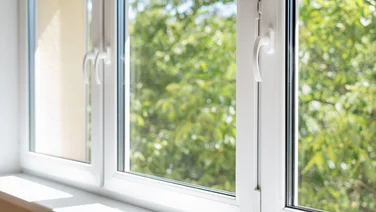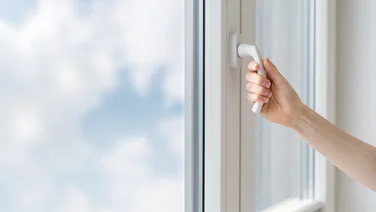- Secondary glazing usually costs around half as much as double glazing
- It typically costs between £300 and £500 per window
- Secondary glazing can reduce noise by up to 50%

Secondary glazing offers a budget-friendly solution, averaging £3,600 to install across a typical three-bedroom home, compared to around £6,000 for full double glazing.
It works by adding a second pane of glass to the inside of your existing windows, improving insulation, reducing noise, and helping lower energy bills without the need to replace them entirely. While double glazing offers better performance and can increase property value, secondary glazing is quicker to install, easier to maintain, and ideal for listed buildings or conservation areas.
If you’re ready to explore your options, just fill in our short form, and professional installers will contact you with quotes to compare.
What type of double glazing do you need?
Get startedHow much does secondary glazing cost?
Secondary glazing, including installation, can cost between £300 and £500 per window.
For a typical three-bedroom house with 8-10 windows, installing secondary glazing will cost around £3,600. For comparison, double glazing costs around £6,000, on average, for a house of this size.
If you want to know how much new windows might set you back, look at our double glazing cost calculator.
The table below outlines the amount a homeowner can expect to pay for secondary glazed windows based on how many windows the property has:
Number of windows | Average cost | Duration of installation |
|---|---|---|
4 windows | £1,600 | 1 day |
8 windows | £3,200 | 1 day |
12 windows | £4,800 | 1-2 days |
*Figures are based on an average of £400 per window.
It’s essential to remember that these figures are just averages. The cost of secondary glazing will vary depending on the number of windows being upgraded, the type of windows in a property, and the type of secondary glazing being fitted over them.
To get a better idea of pricing for your property, it’s worth getting a few quotes from different installers to find the best deal, and if you fill in this form, you can do precisely that.
If you’re interested in financial help, including double-glazing grants for over-60s, have a look at our guide.
The cost of secondary glazing by type
In the section below, we’ve provided a breakdown of the different types of secondary glazing and their costs to help you better understand what’s available.
If you’re more interested in double glazing and want to know whether you can get grants to help subsidise the costs, check out our guide.
- Magnetic secondary glazing costs between £1500 to £2000 for a typical three-bedroom house. It is installed via magnetic strips, making it easy to remove. This is important as the strip needs to be detached to open the primary window. However, it isn’t as effective at retaining heat as it isn’t sealed as tightly.
- Lift-out secondary glazing costs between £3500 and £4000 for a typical three-bedroom house. It is another type of semi-removable secondary glazing, where a single pane of glass and a frame are fitted on top of a fixed window. The frame stays fixed, but as the name suggests, the pane can be lifted to clean and open the primary window.
- Permanent secondary glazing costs around £2000 to £2500 for a typical three-bedroom house. It’s the most expensive due to a strong seal, which results in the best heat retention and draft reduction capabilities. The secondary window provides easy access to the original window because it can be opened through hinges or a sliding mechanism with a choice of direction.

What factors affect the cost of secondary glazing?
The cost of secondary glazing depends on several factors:
- Number of windows in the property
- Type of secondary glazing (permanent vs. temporary)
- Material used for frames and glass
Permanent secondary glazing:
- More expensive than temporary options like magnetic or lift-out
- Involves a more complex design and a longer installation time
Glass considerations:
- Thicker glass increases cost
- Specialised glass types (e.g., noise-reduction glass) are pricier
- Noise-reduction glass can cost upwards of £800 per window
- Noise-reduction glass can cost upwards of £800 per window
Frame material cost ranking (from cheapest to most expensive):
- Wooden window frames (most expensive)
- uPVC window frames (cheapest)
- Aluminium window frames
For more information on aluminium double glazed windows, read our dedicated page.
Is secondary glazing expensive to maintain?
Secondary glazing doesn’t require much maintenance – the panes must be kept clf you live in a three-bedroom house, hiring someone to clean your secondary glazing costs around £30-£60.
This kind of work typically takes a few hours to complete, though this depends on how easy it is to access windows in your property.
If the secondary glazing breaks, repairs cost anywhere from £30 to £200 (or more), depending on the severity of the damage and the type of glazing needed.
What are the benefits of secondary glazing?
Secondary glazing is well worth installing if you want the benefits of double glazing, such as better insulation and lower energy bills, without spending as much.
It offers several key advantages, which are as follows:
- A warmer home: The average home loses 18% of its heat through windows, but secondary glazing can reduce this heat loss by providing an extra insulation layer. A second pane of glass helps lock in warmth and reduce outside drafts, keeping your home cozy.
- Lower energy bills: Better heat retention means less energy is needed to keep the home warm, resulting in lower energy bills. High-quality secondary glazing can reduce energy bills as much as double glazing, cutting up to 20% off bills annually.
- Noise reduction: Secondary glazing is highly effective at keeping noise out, reducing noise pollution by around 45 decibels (dBA) compared to 18-25 dBA for single glazing. That’s about a 50% reduction in noise levels. The gap between the panes is also wider (100–200 mm) than in double glazing (16 mm), making it better at reducing outside noise.
- Extra security: The additional pane of glass makes windows more challenging to break. Secondary window panes are also almost impossible to open from the outside, enhancing your home’s security.
- Easy installation: Installing secondary glazing is much more straightforward than double glazing since it doesn’t require replacing the entire window. Some types, such as magnetic secondary glazing, can even be a DIY project.
- No condensation: Secondary glazing doesn’t typically cause condensation and can even help reduce it. Retaining more heat in the primary window panes prevents them from getting colder than the air inside the room.
- It only takes a day to install: Fitting secondary glazing onto all the windows of a standard three-bedroom house should take about one day. The exact time will depend on the size and number of windows—the more windows you have, the longer it will take—and the type of secondary glazing being installed.
Secondary glazing is also an excellent option for homeowners in listed buildings or conservation areas, where changes to the property’s appearance aren’t allowed. Since secondary glazing is installed on the inside of windows, the original windows don’t need to be replaced, and the external look of the building remains unchanged.
You can learn more about installing double glazing on listed buildings by visiting our page.
Another significant advantage is that secondary glazing is around half the price of double glazing; even less if you opt for magnetic glazing. Plus, it doesn’t require planning permission, though homeowners in listed properties or conservation areas should seek listed-building consent before installation.
While secondary glazing shares many benefits with double glazing, it’s important to note that it might not necessarily add value to a property because it’s an easily removable fixture. In contrast, double glazing typically increases a property’s value by around 10% as a permanent installation.
Next steps
- If you want to improve your home’s insulation and reduce your energy bills but can’t afford double glazing, secondary glazing is a cheaper, effective alternative.
- It’s not complicated to install and can easily be removed. Plus, it won’t alter the appearance of your property while still effectively keeping out noise and drafts.
- And since you’ll be using less energy to heat your home, not only will your bills go down, but your carbon footprint will also go down.
- The same can be said for double glazing and other benefits for homeowners. So, if you’ve decided that double glazing is a better option, we can help you find the best deal. Just fill in our short form, and professional installers will be in touch with their best double-glazing prices.
Summary
- Secondary glazing is a cost-effective alternative to double glazing. It typically costs half as much, ranging from £300–£500 per window.
- It’s a versatile option for improving insulation, reducing noise by up to 50%, and lowering energy bills without altering the appearance of your property.
- Secondary glazing is ideal for listed buildings or conservation areas since it can be installed inside existing windows without replacing them or requiring planning permission.
- Options like magnetic, lift-out, or permanent secondary glazing offer varying levels of heat retention, ease of installation, and pricing to suit different needs.
- Maintenance and repair costs are low, making secondary glazing a practical and budget-friendly choice for homeowners.
- If you’re considering upgrading your windows, secondary glazing offers excellent benefits, but double-glazing may be a better choice for a long-term investment in property value.









